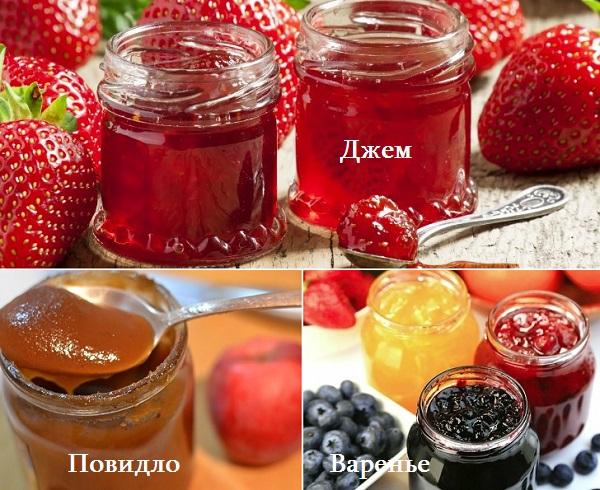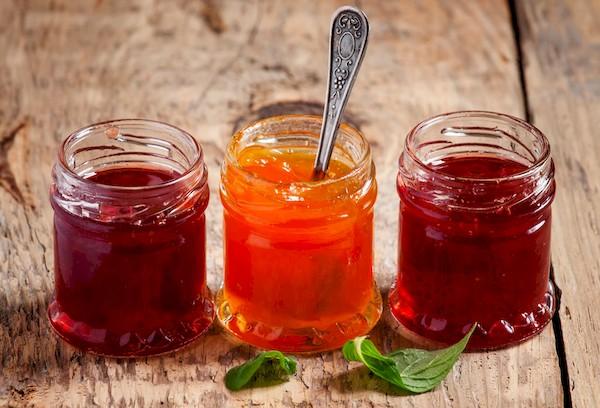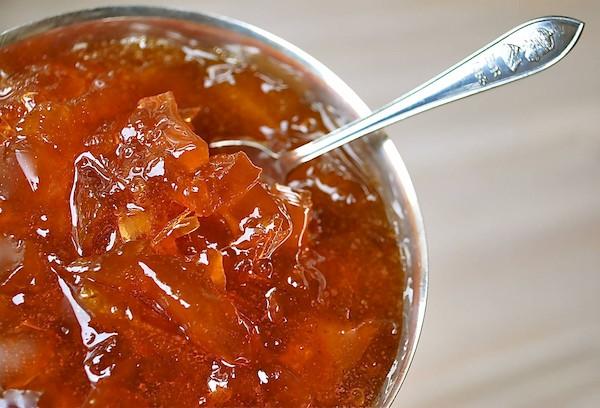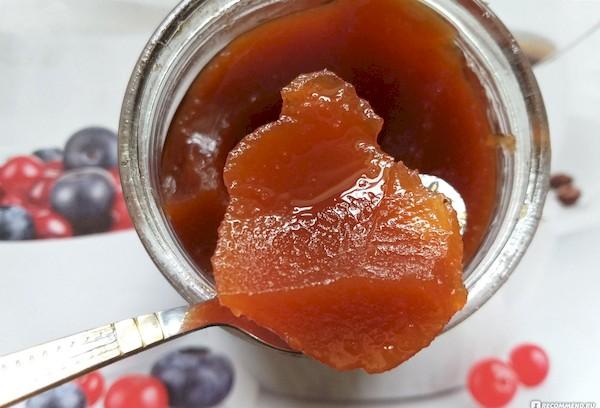What is the difference between jam, preserves and marmalade?
It is a rare housewife who can boast of a clear understanding of the difference between jam and marmalade. To explain the difference, we will look into history and study GOSTs. To be very brief, jam differs from marmalade in its gelatinous syrup and homogeneity, and from marmalade in its less thick consistency.
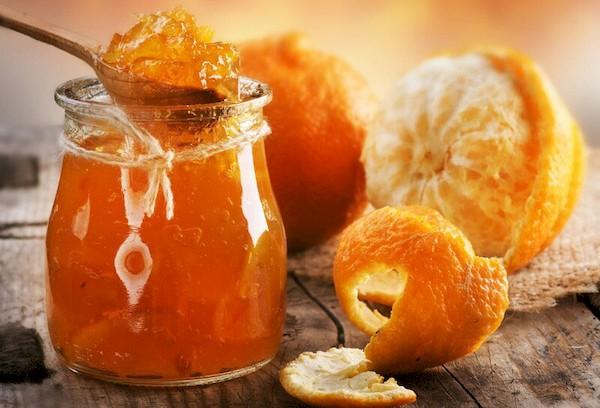
How to distinguish jam from preserves and marmalade?
It’s not difficult to understand where there is jam and where there is preserves or marmalade. You just need to carefully study the product:
- Of the three, only jam resembles jelly.
- On a plate, jam and preserves spread smoothly, but jam never does.
- Jam is noticeably different from jam in color - it is a natural shade for berries (fruits). The jam is always darker, closer to brown.
- If the jam is sugared, then it is the wrong jam or ordinary jam.
The difference in the photo (all three products are cooked from apples):
Differences in the table:
| Jam | Jam | Jam | |
| Consistency | jelly-like, often homogeneous, sometimes with pieces of fruit and berries | medium thickness, with whole fruits or halves | thick, dense, homogeneous (spreads well or cuts with a knife) |
| What is it made from? | any fruits, berries, some vegetables | any fruits, berries, vegetables, as well as rose petals, nuts, dandelion flowers, pine cones, spices | fruits containing a lot of pectin
|
| Particularly popular | orange and strawberry jam | raspberry jam | apple and plum jam |
| Subtleties of cooking | the fruits are crushed or boiled heavily, less often they are preserved whole;
the base is boiled to the desired jelly consistency |
the fruits are boiled whole in sugar syrup, trying to maintain integrity but get rid of hardness;
the base is heated several times, avoiding boiling |
the fruits are ground into puree;
boil for a long time; stir frequently; minimal amount of sugar added |
| Application | as a dessert and addition to pancakes, pancakes, sweet cereals, ice cream, curd masses, yoghurts;
filling for cakes, pastries, puff pastries |
a way to preserve fruits for the winter;
cold treatment (raspberry jam); preparation of drinks; for use with pancakes, pancakes, bread, porridge |
pies and pies, pastries with filling;
like a spread on bread |
Jam - what is it?
England is considered the birthplace of jam. Here it is often used with toast, muffins, tartlets and simply with oatmeal. English jam is viscous; orange jam is considered traditional. Many recipes contain lavender.
There are many legends about the world's first jam. According to one of them, Sarah Jane Cooper, the grocer's wife, boiled oranges and tried to sell the resulting jam. It happened in Oxford in 1874. Very soon the product became so popular that the couple opened their own factory for the production of Oxford jam (still produced today).
The second legend is associated with the name Janit Keiler. Events take place in Scotland at the beginning of the 18th century. The girl's husband brings home oranges bought from the Spaniards. Unfortunately, they turn out to be bitter. Not at a loss, Jenit prepares an amazing dessert from them, which she calls like her name - jam.
In Russia, jam is made in accordance with GOST 31712-2012:
- from fruits and vegetables - whole, chopped, crushed, fresh, frozen, dried, as well as from semi-finished products;
- with sugars;
- with and without pectin.
Jam requirements:
- Must contain at least 35% fruit or vegetable base.
- Dry soluble substances – from 60% (with the name “homemade” – from 55%).
- Jelly-like consistency with evenly distributed vegetables, fruits or parts thereof.
- Sugaring is not allowed.
- The color is the same as the fruits (vegetables) used.
What is jam?
Jam has a long history. The ancient Greeks and Romans boiled fruits and berries for preservation. In the cookbook “Apicus” of the 4th-5th centuries. recipes for jam from apples, plums, lemons, and roses are described. They began to cook it with sugar in Persia. Obviously, the dish was prepared all over the world.
“Jam” is the Russian name for the delicacy, which appeared in the 18th-19th centuries. Traditionally in Russia, fruits and berries were not crushed, but boiled whole or in half in syrup.
At the present time, according to GOST 34113-2017, jam produced in Russia can be made from whole or uncut fresh, frozen or dried fruits, vegetables and their mixtures, walnuts, rose petals by boiling in a sugar solution or syrup. It is allowed to add molasses, pectin, food organic acids and spices. The document describes in detail the requirements for different types of jam.
In particular, vegetables and melons (melon, pumpkin, watermelon) must be peeled and cut into cubes or cubes. The berries must be whole, cleared of sepals, stalks, and ridges. In this case, raspberries can be completely boiled, strawberries - up to 35% of the berries, other types - up to 35%. Unlike jam and marmalade, sugaring of jam is allowed.
What is jam?
The word "jam" is of Polish origin. There are several interpretations. According to one version, “powidła” is associated with the word “powić”, which translates as “what is poured over pies.” According to other versions, the term means “purified broth”, or comes from a kitchen appliance that in ancient times was used to stir the fruit mass while boiling it into jam.
- It is assumed that the method of preparing the delicacy was invented in the Vistula region of the Russian Empire. There were huge plum orchards here. To preserve the harvest, local Polish women peeled the fruits and then boiled them (stewed) in a copper vessel for 3 days.
- Jam gained popularity during Soviet times. A.I. Mikoyan, People's Commissar of the Food Industry, put its production on stream. Soviet plum and apple jam was sold in glass jars and by weight.
Well-ripe fruits that begin to wrinkle at the stalks are best suited for jam. They contain a lot of sugar and pectin, which means the delicacy will be sweet and thick without the use of additives.
Today jam is made in accordance with GOST 32099-2013 from fruit, vegetable puree or a mixture thereof. The base is boiled with sugar or sugar syrup. It is allowed to add pectin, citric acid, and preservatives. The mass should be thick, spreading and homogeneous. A separate type, heat-stable jam should maintain consistency at a temperature of +150 degrees.
Sugaring of jam is excluded by regulations.
Good to know. The consistency of the jam depends on the amount of sugar: with minimal use, the mass becomes spreadable, with maximum use, it becomes thick, suitable for slicing.Adding citric acid helps balance the taste and extend the shelf life of the product.
Question answer
What is the difference between jam and confiture?
The difference between jam and confiture is almost invisible. The sweets have the same uses and are very similar in appearance. Confiture is a type of jam. Its distinctive features: beautiful color, whole, not crushed berries and fruits, jelly-like loose consistency of the syrup. Often confiture is prepared with the addition of agar-agar, pectin or the “Confiturka” veining mixture (so that the mass quickly thickens, the fruits and berries are not overcooked, and retain an attractive shape and color).
How to replace jam (for filling)?
Confiture. If not, you can use jam with the addition of a thickener (pectin, corn starch, potato starch).
You don't need to be a gourmet or a great cook to see the difference between jam, preserves and marmalade. Despite the similar cooking principle, they have many differences: they go through different stages of processing, look different, and differ in taste and consistency. Each product has its own history, its own GOST and application features.
